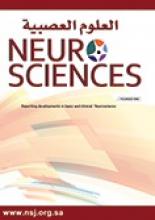Research ArticleOriginal Article
Open Access
Impact of implementing a stroke code on the door to needle time during Hajj at a tertiary center in Makkah, Saudi Arabia
Waleed M. Alzahrani, Afnan A. Sulaiman, Mohammed M. Babakkor, Ziad E. Aljundi, Hamad M. Alhilabi and Rawan A. Aldhahwani
Neurosciences Journal July 2023, 28 (3) 190-194; DOI: https://doi.org/10.17712/nsj.2023.3.20220141
Waleed M. Alzahrani
From the Department of Neurology (Alzahrani, Babakkor, Aljundi), King Abdullah Medical City, the Department of Neurology (Alhilabi), Al Noor Specialist Hospital, Umm Al-Qura University (Aldhahwani), Makkah, and from the Department of Emergency (Sulaiman), King Abdelaziz Medical City, Ministry of National Guard, Health Affairs, Riyadh, Kingdom of Saudi Arabia
MDAfnan A. Sulaiman
From the Department of Neurology (Alzahrani, Babakkor, Aljundi), King Abdullah Medical City, the Department of Neurology (Alhilabi), Al Noor Specialist Hospital, Umm Al-Qura University (Aldhahwani), Makkah, and from the Department of Emergency (Sulaiman), King Abdelaziz Medical City, Ministry of National Guard, Health Affairs, Riyadh, Kingdom of Saudi Arabia
MDMohammed M. Babakkor
From the Department of Neurology (Alzahrani, Babakkor, Aljundi), King Abdullah Medical City, the Department of Neurology (Alhilabi), Al Noor Specialist Hospital, Umm Al-Qura University (Aldhahwani), Makkah, and from the Department of Emergency (Sulaiman), King Abdelaziz Medical City, Ministry of National Guard, Health Affairs, Riyadh, Kingdom of Saudi Arabia
MDZiad E. Aljundi
From the Department of Neurology (Alzahrani, Babakkor, Aljundi), King Abdullah Medical City, the Department of Neurology (Alhilabi), Al Noor Specialist Hospital, Umm Al-Qura University (Aldhahwani), Makkah, and from the Department of Emergency (Sulaiman), King Abdelaziz Medical City, Ministry of National Guard, Health Affairs, Riyadh, Kingdom of Saudi Arabia
MDHamad M. Alhilabi
From the Department of Neurology (Alzahrani, Babakkor, Aljundi), King Abdullah Medical City, the Department of Neurology (Alhilabi), Al Noor Specialist Hospital, Umm Al-Qura University (Aldhahwani), Makkah, and from the Department of Emergency (Sulaiman), King Abdelaziz Medical City, Ministry of National Guard, Health Affairs, Riyadh, Kingdom of Saudi Arabia
MDRawan A. Aldhahwani
From the Department of Neurology (Alzahrani, Babakkor, Aljundi), King Abdullah Medical City, the Department of Neurology (Alhilabi), Al Noor Specialist Hospital, Umm Al-Qura University (Aldhahwani), Makkah, and from the Department of Emergency (Sulaiman), King Abdelaziz Medical City, Ministry of National Guard, Health Affairs, Riyadh, Kingdom of Saudi Arabia
MBBS
References
- 1.↵
- Paramasivam S.
- 2.↵
- Benjamin EJ,
- Blaha MJ,
- Chiuve SE,
- Cushman M,
- Das SR,
- Deo R, et al
- 3.↵
- Béjot Y,
- Delpont B,
- Giroud M.
- 4.↵The National Institute of Neurological Disorders and Stroke rt-PA Stroke Study Group. Tissue plasminogen activator for acute ischemic stroke. N Engl J Med 1995; 333: 1581–1587.
- 5.↵The ATLANTIS, ECASS, and NINDS rt-PA Study Group Investigators. Association of outcome with early stroke treatment: pooled analysis of ATLANTIS, ECASS, and NINDS rt-PA stroke trials. Lancet 2004; 363: 768–774.
- 6.↵
- Emberson J,
- Lees KR,
- Lyden P,
- Blackwell L,
- Albers G,
- Bluhmki E, et al
- 7.↵
- 8.↵
- Almekhlafi MA,
- Alhazmi MA,
- Alsulami SS,
- Almorsy SA.
- 9.↵
- Chen BY,
- Moussaddy A,
- Keezer MR,
- Deschaintre Y,
- Poppe AY.
- 10.↵
- Gurav SK,
- Zirpe KG,
- Wadia RS,
- Naniwadekar A,
- Pote PU,
- Tungenwar A, et al.
- 11.↵
- Mohedano AI,
- Pastor AG,
- Otero FD,
- Alen PV,
- Gómez MM,
- Campo PS, et al.
- 12.↵
- Dharia R,
- Carney M,
- O’Connor M,
- D’Ambrosio R.
In this issue
Impact of implementing a stroke code on the door to needle time during Hajj at a tertiary center in Makkah, Saudi Arabia
Waleed M. Alzahrani, Afnan A. Sulaiman, Mohammed M. Babakkor, Ziad E. Aljundi, Hamad M. Alhilabi, Rawan A. Aldhahwani
Neurosciences Journal Jul 2023, 28 (3) 190-194; DOI: 10.17712/nsj.2023.3.20220141
Impact of implementing a stroke code on the door to needle time during Hajj at a tertiary center in Makkah, Saudi Arabia
Waleed M. Alzahrani, Afnan A. Sulaiman, Mohammed M. Babakkor, Ziad E. Aljundi, Hamad M. Alhilabi, Rawan A. Aldhahwani
Neurosciences Journal Jul 2023, 28 (3) 190-194; DOI: 10.17712/nsj.2023.3.20220141
Jump to section
Related Articles
- No related articles found.
Cited By...
- No citing articles found.





